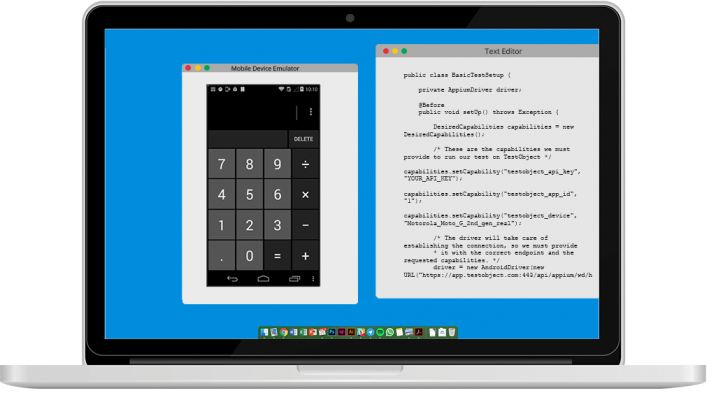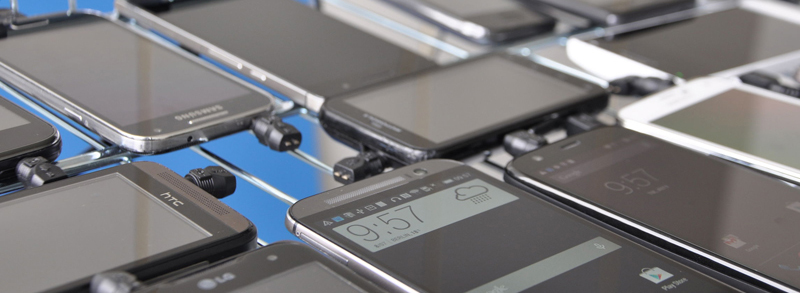There are different strategies for mobile testing, but when it comes to simulators/emulators and real devices, it’s really one or the other approach. Each solution has advantages and disadvantages depending on the stage of the app lifecycle. Simulators/emulators are great for the early stages, but testing on real devices before release is critical to ensuring the success of an application. “The recommended approach is to find the right combination of emulators, simulators and real devices to get the most out of automating your tests.” We’ll cover the pros and cons of iOS and Android emulators as well as real devices, and provide an inexpensive solution for testing both!
Mobile device emulator vs. simulator: what’s the difference?
Many people use either term to refer to a digitized object that mimics a real object and that can be used for testing purposes, but in fact simulators and emulators are two very different things:
An android emulator has the purpose of taking a place in a real (in our case) mobile device. It duplicates every aspect of the original device’s behavior, both hardware and software. It basically mimics all of the hardware used by the real device, allowing exactly the same application to run on it without modification, and all of the software.
Although the simulator sets up a secure environment similar to the operating system of the original real device, it does not try to simulate the hardware of the real device. So, you will see the OS and interface of the device you want to use, but you won’t run into all the problems that the hardware can cause. Some applications may work a little differently, and that’s the main reason why simulators aren’t very reliable.
Advantages and disadvantages of simulators and emulators

Both of the options mentioned above are widely used solutions for mobile app testing. You feel emulators are better because they simulate software and hardware, but that’s not all you want to test when testing an app on a mobile device. As we know, everything has its pros and cons.
Advantages and disadvantages of Android and iOS emulator
Benefits:
- Mimics both software and hardware
- The application works without modification
- Helps you find unexpected behavior
- Tends to be free and open
- Can be plugged into an IDE for early testing during development
- It is a fairly inexpensive solution
Disadvantages:
- Mobile device emulators are very slow (because they simulate both hardware and software)
- Mobile device emulator does not take into account factors such as overheating/battery drain or conflicts with other applications (by default)
- Setting up a good emulator is time consuming and expensive
- They may not be compatible with the application or elements of the application, which means you will need to create patches here and there to keep using the emulator
- Emulators can only support certain versions of the OS
Advantages and disadvantages of iOS and Android simulator
Benefits:
- Fast (because they only simulate software)
- Relatively easy to set up
- Can be used to study application behavior
- Helps you find unexpected behavior, but can also give you false positives
Disadvantages:
- Doesn’t take hardware into account
- Applications may perform slightly differently
- Simulation results may be difficult to analyze because of incomplete data
Both solutions are the optimal solution for early testing when it comes to mobile testing. In the early stages of app development, there is no need to install an expensive solution with real devices. Android and iOS simulators and emulators are ideal for this purpose, with easy setup of different OS versions as well as a cheaper solution for high device coverage.
Advantages and disadvantages of real devices

For starters, real devices give you a real understanding of the application, how it works on real hardware, and all the factors that can affect the application’s performance or failure.
Benefits of real devices
- You test in a real environment with very real conditions (weather, location, network, etc.), Providing real information about the performance of the application
- Screen resolution and brightness can be easily tested in a number of different lighting scenarios
- Real device performance is higher compared to other virtual options
- Compatibility testing is easier
- Easy to replicate errors that users have on their devices
- No false positives as is the case with virtual testing solutions
- Real devices let you test push notifications, geolocation and built-in device sensors such as orientation and Wi-Fi.
- Battery drain issues occurring in your app or in the app compared to other apps by default
- You will be testing on a real OS, with vendor settings, not simple versions of the Vanilla OS.
- Test for incoming interruptions such as SMS and calls
Disadvantages of real devices
- There are thousands of mobile devices, and having a proper testing pool that contains a wide range of devices, it gets really expensive
- Device maintenance must also be taken into consideration
- Difficult to get devices that are only available in foreign countries
- People in other offices or working remotely will not have access to the device
- It’s an expensive and time-consuming solution
Solution: mobile cloud testing
Now we have analyzed all possible options for mobile testing, comparing their advantages and disadvantages, responsibilities and costs. Based on our research, we can easily say that mobile cloud testing is the best solution currently available.
Testing in the cloud means access to hundreds of iO and Android simulators and emulators, as well as real devices, different OS and OS versions right from any browser. You don’t need to buy mobile devices or set up emulators/simulators, you can test on hundreds of mobile devices right from your browser!
What if something breaks? You don’t have to worry, because you’ll always be testing on a working device: no maintenance!
And the best part is yet to come: different mobile testing teams in different locations can work on the same project, see the progress, the tests performed and on which devices.